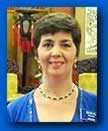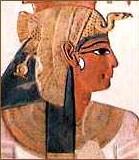Women in Ancient Egyptian Religion
In Old-New Kingdoms, Part I
By Marie Parsons

Religion was an integral part of life in ancient Egypt, for women as well as for men. Women of the household maintained ancestor cults and kept shrines in their homes dedicated to deities especially caring of women, such as the goddess Taweret, and the bandy-legged dwarf Bes. Both these divinities were involved in guarding the woman and child through the pregnancy and childbirth process.

Bes
In addition to the domestic observances and household shrines, many women of the elite class also participated in religious life and temple service, from the Old Kingdom onwards. The husbands of these women were often among the highest officials in the land. Women also often held jobs or had careers outside the temple, and left to do their time of service in the temple. One woman who supervised a royal weaving studio wrote in a letter how she had to leave her job to serve her month of temple duty.
Hundreds of non-royal women are known to have served as priests, or hmt-ntjr, in the cults of goddesses like Hathor and Neith. In the Old Kingdom women also served as prophets in the cults of the gods Thoth and Ptah. Wives of kings were also often priestesses in the Hathor cult.
The title priestess of Hathor remained a common one for women into the Middle Kingdom. Some priestesses of Hathor bore the title of Mrt, which is a title for women attested from earliest times. Their duty was to sing and play music to greet the king and the deity at the temple, but some Mrt priestesses apparently were responsible for managing the fields and estates, and ultimately, the financial security, of the cult center of their goddess.
The records of the province of Kusae give an idea of just how much prestige and probably wealth went along with the prophetship of the Hathor cult. Three generations of one noble family were leaders of the local temple. The governor was the overseer of priests and the women of his family were the priestesses.
It is clear that social or economic status affected a womans opportunities to belong in these priesthoods, yet there was no sex discrimination with regard to holding the title of Prophet of Hathor. In fact, originally the priesthood of Hathor was predominantly female. A woman in Hathor cults could even be priestess in more than one temple, and positions in the temple hierarchy were not inherited. There is evidence of "mother-in-law/daughter-in-law" connections, meaning that women were identified as "X, being daughter-in-law to Y." Perhaps the older women serving in the cult sought wives for their sons from among the younger temple women.
Women also served as wbt-priests, a different rank in the priestly hierarchy, in the Hathor cult as well as serving the gods Khonsu and Wepwawet. Priestesses who held the rank of wbt, meaning "pure one", received the same payment for their services as did a wb-priest. A few wbt priestesses were also known from the Middle Kingdom.
There is evidence that in the Old Kingdom the office of Chantress existed. The Chantress participated and addressed the king directly in the very important national celebration of his jubilee. Women as well as men could also serve as ka-servants who looked after the mortuary cults, pouring libations, making offerings, and reciting the proper formulas.

Also first appearing during the Old Kingdom were troops of female temple musicians called khener, which were involved first with goddess cults but later with funerals and then with the cults of the gods as well. The khener were attached to religious and secular institutions. In the tomb of the 5th Dynasty official named Ti, a wall scene shows a group of male musicians and five female dancers followed by three clapping women, The captions say "dancing by the musical troupe" and "clapping by the musical troupe." A letter from the Middle Kingdom written to a temple scribe instructs the recipient to bring a list of people including a "shemayet Sattepihu who is in the musical troupe."

Musicians frequently carried a sistrum, as shown in the accompanying picture of the priestess Anhai. A sistrum, called seshesht in Egyptian, was a musical rattling instrument, sacred to Hathor. Many of these sistra were made of wood, stone or faience, though some from the Graeco-Roman period were made of Bronze. The priestesses are depicted holding it at their sides, or shaking it. They rattled the sistrum before the divinity and made music for their kas.
The musician-priestesses also carried a menit, a necklace, which consisted of a number of strands strung with small beads that came together into a single strand of large beads at either end. The strands attached to a counterpoise, which fell down the back and held the necklace in place. A few 18th Dynasty scenes show women shaking their sistra in the Festival Temple of Tuthmosis III at Karnak, in the colonnade of the temple of Luxor and in the Red Chapel of Hatshepsut.
In the Middle Kingdom there were musician priestesses, or khenywt, attached to the temple of Osiris at Abydos and the Hathor temple at Cusae. In the New Kingdom the khenywt were attached to the cults of Osiris, Isis, Mut, Hapi, Hrosu of Anibeh in Nubia, Hathor of Dendera, the Great Ennead of Karnak, Wepwawet, and Amun-Ra.

In the New Kingdom these troupes were in charge of women with the title "weret khener," or "great one of the troupe of musical performers." Frequently the great one was the wife of the high ranking priest in a cult, thus suited to head that musical troupe, or she was wife of a high-ranking official. Wives of chief priests of Montu, Khons and Thoth were in charge of the musical troupes of their cults, as was the wife of the mayor of the Faiyum, during the reign of Tuthmosis IV, who was the weret khener for the cult of Sobek.
The "great one" was perhaps responsible for the training, practice and performances of the troupe, and for seeing that things went correctly during the ritual.
Even when the khener included male musicians, the leadership positions continued to be held by women.
By the beginning of the 18th Dynasty, women no longer held priestly titles. In the Old and Middle Kingdoms, priests had been officials who spent part of their time serving in their local cult. By the New Kingdom, priesthood was a full-time job in which men made their careers as a branch of the bureaucracy. The commonest title for women linking them to the temple cult was shemayet, or musician. Though there were musicians in the Old and Middle Kingdoms, shemayet did not appear as a title on monuments until the New Kingdom. It was the commonest title for elite women after "mistress of the house."
Frequently in late New Kingdoms tomb paintings and on stelae women are depicted making offerings to the deity or performing rites for deceased family members. Several late Ramesside letters indicate women participated in the administration of temples. One Chantress of Amun-Ra named Henuttowy left a long letter addressed to her husband the necropolis scribe, describing how she received grain shipments for the temple, and was responsible for getting food offerings to the altar. Another woman, a Principal of the Khener of Amun-Ra, named Herere, had enough authority of position to order a troop captain to distribute pay rations to the royal necropolis workers.
One of the highest ranks a woman could attain in a cult of the god was the position known as "Gods Wife." In the Middle Kingdom at least two women with this title are found, one serving Min at Akhmim and the other, serving Amun of Thebes. The title of Gods Wife of Amun began to be used about the start of the New Kingdom. Since the victors against the Hyksos invaders had come from the Theban region it was important to attribute their success to the power and intervention of Amun. There are no known scenes showing the holder carrying out any functions connected with the office. In the reign of Ramesses VI his daughter was installed as gods wife, and a funerary stela and fragmentary pyramidion belong to her.
Three sets of scenes in the chapelle rouge involve the gods wife. In one, the gods wife is shown entering the open court of the temple together with another female figure, a male figure, and many priests. In the court, the gods wife and a male priest face each other holding a firebrand, while in the next, the gods wife turns, perhaps to light a brazier with the torch. Then the gods wife and priest face each other again, both holding fans on long handles, each with an image of a bound captive on its face. Presumably the gods wife is participating in a ritual of burning the enemies of Egypt.
During the New Kingdom, the title of "Gods Wife of Amun" was held by royal women. The title was awarded to high-ranking ladies in the royal family, usually the wife, mother, or eldest daughter of the king. It was held first by Queen Ahhotep and then Queen Ahmose Nefertari. She was wife of king Ahmose and mother of Amenhotep I, who was depicted performing a range of public religious duties including participation in the public processionals with the priests of Amun.

Next the title was held by Hatshepsut, who received it from Meritamun, daughter of Ahmose Nefertari, and passed it to her own daughter Neferure. When Tuthmosis III ruled alone, at the end of his reign it was held by his own daughter Meritamun, and then in the reign of Amenhotep II it was given to his mother Meritra, and in the next reign to Tiaa, mother of Tuthmosis IV. When the Amun cult was abandoned by Akhenaten and Nefertiti, this position disappeared, although royal women are shown officiating in the new state cult. Later in the 19th Dynasty, the position of Gods Wife of Amun was resurrected.
Another priestly title that appeared in the 18th Dynasty is duat netjer or "Divine adoratrice." During Hatshepsuts reign the title was held by the daughter of the chief priest of Amun, and in the reign of Tuthmosis III by the mother of the kings principal wife. In the Third Intermediate Period this title became associated with the title gods wife of Amun and the same woman bore both titles.
After the high priest of Karnak became the virtual ruler of Upper Egypt after the 20th Dynasty ended, later dynasties ruled from the north, while Thebes and the south were for al practical purposes ruled by the chief priest of Amun. Daughters of the High priest filled the role of Gods Wife but also took the old queenly title of Lady of the Two Lands and wrote their names inside the royal cartouche.
Sources:
-
The Remarkable Women of Ancient Egypt by Barbara S. Lesko
-
Position of Women in the Egyptian Hierarchy by Aylward Blackman, JEA 7
-
Women in Ancient Egypt by Gay Robins
-
Women in Ancient Egypt by Barbara Watterson
-
Daughters of Isis by Joyce Tyldesley
-
Dictionary of Ancient Egypt by Ian Shaw and Paul Nicholson
Marie Parsons is an ardent student of Egyptian archaeology, ancient history and its religion. To learn about the earliest civilization is to learn about ourselves. Marie welcomes comments to marieparsons@prodigy.net.
Last Updated: Aug 4th, 2011

